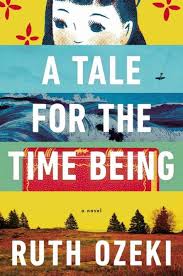A Tale for the Time Being
By Ruth Ozeki
Viking Penguin
422 pages, $30
Reviewed by Vivian Moreau
For those of you who walk West Coast beaches with eyes trawling for washed-up treasure, the Man Booker Prize-nominated A Tale for the Time Being may be a vicarious pleasure. But if you’re hoping for a narrative sustained over 422 pages, you may be a bit disappointed. But just a bit because Ruth Ozeki’s story — that veers from Tokyo’s seedy Electric Town to a moss-embraced monastery — is readable, timely, and for the most part, fun.
It’s post Fukushima, and a barnacle-encrusted garbage bag washes up on a British Columbia Gulf island – likely Cortez but it’s never named – and inside is a Hello Kitty lunchbox with a 10-year-old diary, a circa-Second World War wristwatch, and a bundle of letters from the same wartime era. It’s picked up by Ruth - the character shares the same name as the author – who begins to read the diary in her rural wooded home.
Teenager Nao has recently moved to Japan from California with her parents. Her father is listless to the point of suicide after losing his Silicon Valley job; her mother spends her days watching jellyfish at the aquarium. Tormented by her bullying classmates and teacher, Nao skips school to write in a manga cafe. She intends to chronicle the story of her activist-turned-Zen Buddhist nun great-grandmother Yasutani Jiko, who, at 104, lives Yoda-like in a tiny, mountainside monastery. Nao had been sent to spend the summer at the monastery, where Jiko serenely unravels the secrets behind Nao’s burns, scars, and anger. By the end of summer, Nao is wiser, having learned some of Jiko’s secrets.
But did Nao survive the tsunami, Ruth wonders as she reads the journal in allotments, not wanting to get to the end too quickly. In alternating chapters, Ruth’s narrative of her small island life filled with clichéd rural folks is an annoyance, but perhaps meant to be. Ruth the Character is a frustrated writer that Ruth the Author takes on a meta-fiction dalliance, ruminating on reader/writer relationships that push the true reader — you and me — away from who we really want to hear about: Nao.
Ozeki, a Zen Buddhist and filmmaker, does have a gift: her ability to create believably the delicate, healing monastery life as well as the frenetic pop-culture-infused Tokyo that alternately shelters and abuses Nao. Also remarkable is Nao’s fresh voice, the teenager moving between those worlds:
“And because we’re friends, here’s something else I will share with you. It’s kind of personal, but it’s really helped me out a lot. It’s Jiko’s instructions on how to develop your superpower. I thought she was kidding when she said it. Sometimes it’s hard to tell when a really, really old person is kidding or not, especially if she’s a nun.”
Ozeki has worked as a bar hostess in Japan and also sets Nao in that eerie workplace for a short time. But Nao figures out she has more important things to do, like write in her journal, the time transporter that connects Nao, Ruth the reader/writer, Ozeki the author, and you and me, the readers. The meta-fiction- Zen-Buddhist-traverse works in some places, with footnotes that could be fiction or not. “Can’t find reference to medical cafes or Bedtown. Is she making this up?” character Ruth asks, tripping up the reader. Is this the same Ruth who explains in footnotes that Ijime is Japanese for bullying and omuraisu is a rice pilaf-filled omelette seasoned with ketchup and butter?
Meta-fiction when taken too far is like a plot spoiler. It can deflate verisimilitude, that diaphanous place to which fiction readers either float or strain. As with the waves Juki uses as life metaphor to explain to Nao the futility of flailing against the inevitable, sometimes it’s best to not try too hard. Nao’s conclusion is akin to the reader’s experience in absorbing A Tale for the Time Being: “I never completely understand what she’s saying, but I like that she tries to explain it to me anyway. It’s nice of her.”
Vivian Moreau is a Victoria freelance writer and editor.

{ 5 comments… read them below or add one }
Nea Cotsoche:Prababil asta e si scopul reclamei respective, sa ma agaseze atat de tare incat sa cumpar repede masina si sa-l salvez pe nenorocitul ala care toata ziua tipa ca se arunca.. 🙂
The Killers comparison has me intrigued. I’ve been long estranged from the mainstream Christian music scene due to the constant U2 sound which just got ridiculously old. Not going to lie, the fact that it’s still present here makes me wary of checking it out. But it sounds intriguing enough that I just might anyway.
If you have not already seen it or it has not already been recommended to you, watch Miss Representation. It is a great look at the way women are seen in society. I give you fair warning, though, it will piss you off.
Obviously Chernobyl cannot happen here : There were 2.5 million Curies of Radioactivity at the Chernobyl plant and Vermont Yankee has about 40 million Curies. So…in the event of a meltdown V.Y.would make Chernobyl look like a walk in the park !!!In 1976 3 nuclear engineers quittheir jobs at General Electric Nuclear to give testimony beforea Joint Committee on Atomic Energyand voice their concerns about inherent design problems with the Mark I BWR.2 of their predictions have so far come true : Problems with the Torusand Cracks in the Steam Dryer.Do we have to wait for a meltdown!?
José Barros,Não vale a pena tentar nem calçando luvas.O José já lhe explicou isto tudo com paciência de santo e foi o mesmo que estar a falar para uma porta.O rb é a Tânia da blogosfera com a agravante de ter um problema na vista que só lhe permite olhar para o lado partidário situacionista.